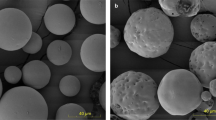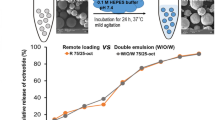Abstract
Purpose. The development of a sustained release formulation for recombinant human growth hormone (rhGH) as well as other proteins requires that the protein be stable at physiological conditions during its in vivo lifetime. Poly(lactic-co-glycolic acid) (PLGA) microspheres may provide an excellent sustained release formulation for proteins, if protein stability can be maintained.
Methods. rhGH was encapsulated in PLGA microspheres using a double emulsion process. Protein released from the microspheres was assessed by several chromatrographic assays, circular dichroism, and a cell-based bioassay. The rates of aggregation, oxidation, diketopiperazine formation, and deamidation were then determined for rhGH released from PLGA microspheres and rhGH in solution (control) during incubation in isotonic buffer, pH 7.4 and 37°C.
Results. rhGH PLGA formulations were produced with a low initial burst (<20%) and a continuous release of rhGH for 30 days. rhGH was released initially from PLGA microspheres in its native form as measured by several assays. In isotonic buffer, pH 7.4 and 37°C, the rates of rhGH oxidation, diketopiperazine formation, and deamidation in the PLGA microspheres were equivalent to the rhGH in solution, but aggregation (dimer formation) occured at a slightly faster rate for protein released from the PLGA microspheres. This difference in aggregation rate was likely due to the high protein concentration used in the encapsulation process. The rhGH released was biologically active throughout the incubation at these conditions which are equivalent to physiological ionic strength and pH.
Conclusions. rhGH was successfully encapsulated and released in its fully bioactive form from PLGA microspheres over 30 days. The chemical degradation rates of rhGH were not affected by the PLGA microspheres, indicating that the internal environment of the microspheres was similar to the bulk solution. After administration, the microspheres should become fully hydrated in the subcutaneous space and should experience similar isotonic conditions and pH. Therefore, if a protein formulation provides stability in isotonic buffer, pH 7.4 and 37°C, it should allow for a safe and efficacious sustained release dosage form in PLGA microspheres.
Similar content being viewed by others
REFERENCES
J. L. Cleland and A. J. S. Jones. Pharm. Res. 13:1462–1473 (1996).
O. L. Johnson, J. L. Cleland, H. J. Lee, M. Charnis, E. Duenas, W. Jaworowicz, D. Shepard, A. Shahzamani, A. J. S. Jones, and S. D. Putney. Nature Med. 2:795–799 (1996).
R. Pearlman and T. A. Bewley, In: Stability and Characterization of Protein and Peptide Drugs: Case Histories, J. Y. Wang and R. Pearlman, Eds., Plenum Press, New York, pp. 1–58 (1993).
P. A. Burke. Proceed. Intern. Symp. Control. Rel. Bioact. Mater. 23:133–134 (1996).
J. L. Cleland, A. Lim, L. Barrón, E. T. Duenas, and M. F. Powell. J. Controlled Rel. in press (1997).
J. Yang and J. L. Cleland. J. Pharm. Sci., in press (1997).
G. Teshima and E. Canova-Davis. J. Chromatog. 625:207–215 (1992).
J. E. Battersby, W. S. Hancock, E. Canova-Davis, J. Q. Oeswein, and B. O'Connor. Int. J. Peptide Protein Res 44:215–222 (1994).
G. Teshima, J. T. Stults, V. Ling, and E. Canova-Davis. J. Biol. Chem. 266:13544–13547 (1991).
E. C. Roswall, V. R. Mukku, A. B. Chen, E. H. Hoff, H. Chu, P. A. McKay, K. C. Olson, J. E. Battersby, R. L. Gehant, A. Meunier, and R. L. Garnick. Biologicals 24:25–39 (1996).
F. W. Okumu, J. L. Cleland, and R. T. Borchardt. J. Controlled Rel., in press (1997).
J. L. Cleland. In: Vaccine Design: The Subunit Approach, M. F. Powell and M. Newman, Eds., Plenum Publishing, New York, NY, pp. 439–472 (1995).
N. Fogh-Andersen, B. M. Altura, B. T. Altura, and O. Siggaard-Andersen. Clin Chem. 41:1522–1525 (1995).
J. L. Cleland, E. T. Duenas, A. Daugherty, M. Marian, J. Yang, M. Wilson, A. Shahzamani, H. Chu, V. Mukku, Y.-F. Maa, C. Hsu, and A. J. S. Jones. Proceed. Intern. Symp. Control. Rel. Bioact. Mater. 22:143–144 (1995).
J. L. Cleland, E. T. Duenas, A. Dougherty, M. Marian, J. Yang, M. Wilson, A. C. Celniker, A. Shahzamani, V. Quarmby, M. Chu, V. Mukku, A. Mac, M. Roussakis, N. Gillette, B. Boyd, D. Yeung, D. Brooks, Y.-F. Maa, C. Hsu, and A. J. S. Jones. J. Controlled Rel. in press (1997).
Author information
Authors and Affiliations
Corresponding author
Rights and permissions
About this article
Cite this article
Cleland, J.L., Mac, A., Boyd, B. et al. The Stability of Recombinant Human Growth Hormone in Poly(lactic-co-glycolic acid) (PLGA) Microspheres. Pharm Res 14, 420–425 (1997). https://doi.org/10.1023/A:1012031012367
Issue Date:
DOI: https://doi.org/10.1023/A:1012031012367




